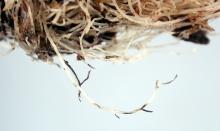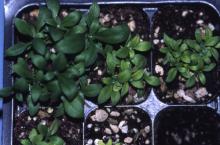Cause Berkeleyomyces sp. (formerly Thielaviopsis basicola) is a widely distributed root pathogen reported from at least 30 plant families, including many ornamental plants. Untreated or improperly treated field soil can be a source of T. basicola if used in potted-plant culture. Most soilless media including commercial peat moss are clean. T. basicola spores from other areas of a greenhouse facility can contaminate potting media and result in disease problems. The pathogen forms thick-walled chlamydospores, which can survive several years in soil. Root exudates stimulate chlamydospores to germinate in soils whose pH ranges from 5 to 8.5, and root rot tends to be more serious in plants grown in neutral to alkaline soils. Root rot also generally is more serious for plants grown in soil at 55°F to 70°F but can be severe on some plants at as high as 77°F. Disease severity tends to be worse when temperatures are not optimal for plant growth, and the soil moisture-holding capacity is 70% or above for extended periods.
Plants that frequently develop black root rot include Begonia sp., Calibrachoa, Cyclamen persicum, Euphorbia pulcherrima (poinsettia), Fuchsia x hybrida, Gerbera jamesonii (African daisy), Pelargonium x hortorum (florist's geranium), Pericallis x hybrida (cineraria), Petnia, Salvia, Scindapsus aureus, and Viola spp. (pansy). Alyssum, kinnikinnick, Lithodora, marigold, petunia, phlox and Vinca also have problems with black root rot.
Symptoms Aboveground symptoms are not unique to T. basicola but are typical of many root diseases or soil conditions that are detrimental to root growth. Plants often are chlorotic and stunted and may wilt if root rot is severe. Initially, roots or portions of roots killed by this pathogen are brown and could be mistaken for Rhizoctonia root rot. The diagnostic flat, black root lesions occur because of the abundant formation of chlamydospores on the root surface and in the root cortex. Multiple root diseases, such as Pythium or Rhizoctonia can occur coincidentally with black root rot.
The fungus can be seen in infected tissue with a compound microscope. The fungus can be isolated readily by spreading a thin layer of soil or colonized root tissue over 5-mm-thick carrot root disks in sterile dishes. Sterile water is then atomized over the disks to moisten the soil or roots; after 2 to 4 days at room temperature, the incubated disks are rinsed with water and incubated again. If the fungus is present, endoconidia form in about 6 days followed by chlamydospore formation. Bead-like chains of endoconidia can be observed with a dissecting microscope.
Cultural control Ruthless sanitation and proper environmental controls are necessary of successful disease management. Fungicides will not compensate for poor sanitation or environmental controls.
- The disease is greatly reduced at pH levels below 5.5. Some plug producers adjust media pH, however, finished plants often are grown in commercial peat mixes that are buffered at a pH between 6 and 6.5. Also, note that plants like geranium and marigold naturally drop the growing media pH while petunias tend to naturally increase the media pH.
- Use soilless planting media. If field soil is a component of the growing medium, treat it with steam (122°F for 30 min) or chemical fumigants.
- Use ammoniacal fertilizer and do not apply excessive potassium.
- Dispose of diseased plants and plant material promptly.
- Do not let contaminated tools or hands contact sterilized planting media.
- Keep entire propagation and growing areas clean.
- Control fungus gnats and shore flies, which may serve as vectors. Consult the PNW Insect Management Handbook for currently effective tactics.
- After the production cycle, remove any remaining plants and disinfect the growing area.
- Avoid reusing pots or trays from a previous crop for propagation. If pots must be reused then wash off all debris and soak in a sanitizing solution or treat with aerated steam for 30 min.
Chemical control Fungicides work best when used as a protectant in combination with cultural controls. Chemical control may require multiple applications. If the disease is noticed early, also treat with fungicides but in general fungicides will not rescue a crop. This disease can be difficult to control, and often the higher rate is more effective. Read each label before using and observe all restrictions and regulations.
- Affirm WDG at 0.25 to 0.5 lb/100 gal water. Group 19 fungicide. 4-hr reentry.
- Avelyo at 2 to 3 fl oz/100 gal water. Group 3 fungicide. 12-hr reentry.
- Medallion WDG (or Spirato GHN) at 1 to 2 oz/100 gal water. Use as protectant before symptoms occur since it is ineffective once plants are infected. Do not use on impatiens or Geranium. Use with oils or adjuvants may damage plant. Group 12 fungicide. 12-hr reentry.
- Orkestra at 8 to 10 fl oz/100 gal water as a soil drench. Can be used in the landscape and many other sites. Group 7 + 11 fungicide. 12-hr reentry.
- Terraguard SC at 2 to 8 fl oz/100 gal water is registered as a drench. Might produce a plant growth regulation effect on some crops. Group 3 fungicide. 12-hr reentry.
- Thiophanate-methyl is registered as a drench for a wide range of crops and sites. Higher rates have resulted in better control. Group 1 fungicides. 12-hr reentry.
- Cleary's 3336 EG at 8 to 16 oz/100 gal water.
- OHP 6672 4.5 F at 7.5 to 20 fl oz/100 gal water.
- SysTec 1998 FL at 10 to 20 fl oz/100 gal water. Washington Only.
Combination Fungicides
- Banrot 40 WP is registered as a drench for a wide range of crops. For bedding plants, use at 4 to 8 oz/100 gal water applied to 800 sq ft of bed area. Group 1 + 14 fungicide. 12-hr reentry.
Biological control
- Bio-Tam 2.0 or Tenet WP or Obtego (Trichoderma asperellum and T. gamsii) at 0.5 to 1.5 lb/cubic yard of substrate. See label for details and other application methods. No restrictions on reentry when soil incorporated. O
- PlantShield HC (Trichoderma harzianum Rifai strain T-22) at 3 to 5 oz/100 gal water as a soil drench. 4-hr reentry.O
References Daughtrey, M.L., Wick, R.L., and Peterson, J.L. 1995. Compendium of Flowering Potted Plant Diseases. St. Paul, MN: APS Press.
El-Hamalawi, Z.A. 2008. Acquisition, retention and dispersal of soilborne plant pathogenic fungi by fungus gnats and moth flies. Ann. Appl. Biol. 153:195-203.





